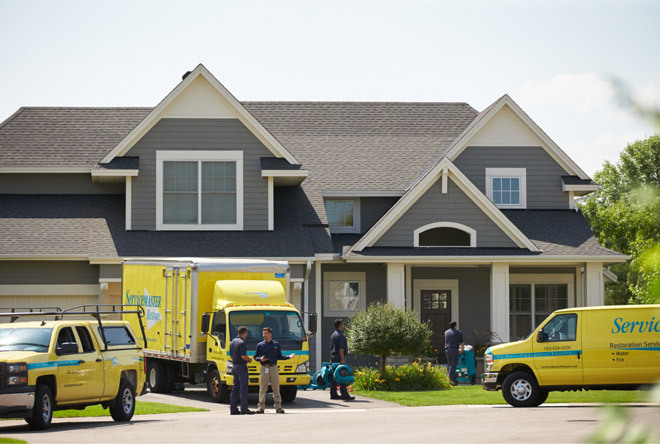Water Damages Emergency Response
Serving the Boulder County and North Denver Metro area for over 30 years.
Preventing Water Damage & Emergency Response Services
Our team at ServiceMaster of Boulder County offers prevention tips and the precise water extraction and restoration services needed to help homeowners and businesses recover safely from flooding, water disasters, and water damages regardless of cause or origin.
Disaster Doesn't wait. Call now for Immediate 24 Hour Emergency Response: 303-529-7268
Can My Carpet Be Saved Following Major Flooding with Water?
As we are all too aware, carpet for your home can be very costly. Just because you have had a flood in your home that has affected your brand new carpet does not necessarily mean the carpet is ruined or will need to be replaced. Below are some considerations taken when determining whether or not carpet affected by flooding in your home or business can or should be salvaged.
Restoring Wet Carpet Emergencies
Wet carpet may be salvageable, depending on a few mitigating factors and the application of correct procedures during the restoration process. At Service Master of Boulder and Service Master of Westminster, we understand carpet is a huge investment and accordingly, we want to protect you from major loss whenever possible. Here are some important things to understand and consider when restoring water damaged carpet.
What Type of Water is Involved
There are three categories used to classify water based on the level of contamination.
Category 1 Water – This category is often referred to as “clean water”. This water originates from a source that is not typically a health hazard, such as a broken water supply line.
Category 2 Water – This category of gray water, falls within the two extremes, containing contaminates that can potentially cause illness. Sources of gray water include sump-pump failures and backflow from washing machines and dishwashers. Carpet exposed to this category of water can often be saved after removing the affected pad.
Category 3 Water – This category is called black water, is highly contaminated liquid that poses a serious health threat to humans. An example would be flood water containing raw sewage. In regard to wet carpet, industry guidelines recommend the removal and safe disposal of the whole carpet and cushion submerged in raw sewage water.
Another important thing to look for is furniture staining where furniture legs or bases touched the wet carpet. Stains like rust from metal legs or bases can often be removed while wood stains typically will not come out of wet carpet.
How long was the carpet exposed to water and under what conditions?
As time lapses, the condition of the water can deteriorate and consequently, so can the carpet. If not treated promptly, contamination levels rise in category 2 water, which may result in a downgrade to category 3. Likewise, other factors such as temperature and stagnant air play into the mix, which can aggravate the situation. In addition to harmful bacteria and viruses in contaminated water, prolonged exposure to wetness fosters the growth of mold in carpet.
What is the age and pre-flood condition of carpet?
In situations where a carpet is so worn out or old, replacing it may be a practical and economical choice. Our team at Service Master of Boulder and Service Master of Westminster will inspect your carpet and help to determine its value using defined industry standards.
Cleaning and Drying Wet Carpet
In many situations, wet carpet can be salvaged by following industry standards recommended by the Institute of Inspection, Cleaning and Restoration Certification. Our IICRC certified team at Service Master of Boulder and Westminster will act quickly to restore your water damaged carpet.
Extract Water — We use sophisticated techniques and specialized equipment to remove water from the carpet installation. If the cushion and sub-floor or concrete underneath are affected, it may be necessary to use weighted extraction or even remove the carpet and padding depending on the cleanliness of the source water.
Dry and Dehumidify — Through the use of high-speed air movers and other specialized equipment the drying process is accelerated. We install commercial dehumidifiers to reduce humidity levels and create the proper environmental conditions to ensure the carpet is completely dried out.
Clean and Sanitize — To keep your home or business safe, we apply antimicrobial agents to carpet affected by an unsanitary source that inhibit the growth of mold and other unhealthy microorganisms. We thoroughly steam clean the carpet using powerful truck-mounted units, specialized cleaners and then deodorize to remove odors triggered by wet carpet.
Monitor and Control — During the carpet restoration process our trained technicians monitor and control the conditions in the environment to facilitate rapid moisture evaporation.
Water Damage Emergencies from Frozen Pipes and Prevention
Especially in the Colorado wintertime, if you’re planning to go on vacation, be sure to take a few precautions to prevent your pipes from freezing and causing emergency water damages. Even though temperatures are getting milder, the weather in Boulder, Colorado can be unpredictable.
Temperatures Below 20 degrees Can Freeze Pipes in Different Home Areas
As a general rule, temperatures that fall to 20 degrees or below can cause pipes in your home to freeze. A frozen pipe can burst, resulting in a flood and water damage to your home and belongings.
Pipes in unheated and unprotected areas are most vulnerable to freezing. These would include uninsulated water lines and pipes located in a crawl space, basement, attic and garage. Also, pipes running along exterior walls are exposed to colder conditions, which increase the risk of freezing. An example would be the plumbing under bathroom and kitchen cabinets. This is especially true if there’s a small open space or crack on an exterior wall exposing the pipes to cold, windy air.


